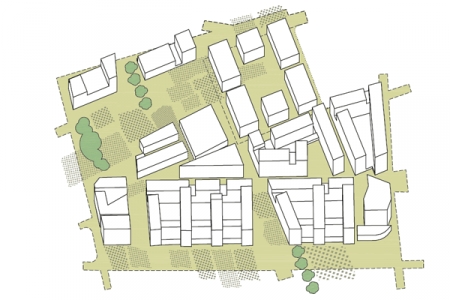In Motion
Barcelona (ES) – Winner
TEAM DATA
Team Representative: Maria Langarita Sanchez (ES) – architect; Associates: Víctor Navarro Ríos (ES) – architect
Contributors: Ángela Juarranz Serrano (ES), Ramón Martínez (ES) – architects; Guillermo Diego (ES), Jacob Kummer (UK) – students in architecture
Langarita Navarro Arquitectos, Calle Grijalba, 8, 28006 Madrid – España
+34 915 645 984 – estudio@langarita-navarro.com – www.langarita-navarro.com
See the complete listing of portraits here
See the site page here

J. Kummer, R. Martínez, Á. Juarranz Serrano, M. Langarita Sanchez, V. Navvaro Ríos & G. Diego
INTERVIEW
Click on the images to enlarge
1. How did you form the team for the competition?
We are lucky to have at the office a vibrant team of talented and enthusiastic people.
2. How do you define the main issue of your project, and how did you answer on this session main topic: Adaptability through Self-Organization, Sharing and/or Project (Process)?
We started the contest defining the “adaptable city” as a city capable of managing times of change and keeping up with the speed of its inhabitant, and the “self-sufficient city” as a city that thinks of its life-cycles synchronized with the production of resources. Those two definitions guided us through the whole competition. We applied these concepts to the different scales of the project. At the urban scale we proposed to reduce the prophylactic layer of hard pavements that cover the ground. Making it porous and permeable we aim to synchronize natural and civic cycles. The building is planned to act as a group of plots/slabs of municipal management. Each of the platforms functions as a plot equipped so that its management and reprogramming can be done independently. The purpose is to increase the diversity by creating a structure that is rapidly able to assimilate unknown needs.
3. How did this issue and the questions raised by the site mutation meet?
The city of Barcelona has been through history a laboratory of urban experiments and bold housing developments. We tried to be part of that research by introducing new strategies that bring adaptability, self-sufficient logics, the ecosystem approach and the social engagement to housing.
4. Have you treated this issue previously? What were the reference projects that inspired yours?
Yes, we could say that this project has been a summary of several ideas we have been working with in the last years in the theoretical field an in our practice. The project is based on the understanding that buildings can no longer be seen as a unit or a closed object but as a heterogeneous group of agents. According to the consistency of the matter that constructs and inhabits the buildings, it is possible to establish a stratification of changes where people can manage tenacity, resistances and affections.
We usually relate architecture to inorganic and inert manifestations, to everything that is hard and slowly erodes – we call that part of the architecture the “Bust”. However, we claim an alternative look to its complementary organic and soft side. One that breaks down and leaves no trace when it disappears. One that is easy to handle and requires actions and affections from its inhabitants to activate it. One that cannot be preserved without them. We call “Pelt” that architecture and the world it builds.
5. Today –at the era of economic crisis and sustainability– the urban-architectural project should reconsider its production method in time; how did you integrate this issue in your project?
The adaptable city requires construction strategies that are fast, economic and that their impact on the life-cycles of materials is minimized in the event of transformation. This implies that the building can no longer be seen as a unit or a form but as a heterogeneous group of elements with different rates of change.
6. Is it the first time you have been awarded a prize at Europan? How could this help you in your professional career?
It is the first time that we have participated in Europan. Winning it is always helpful not only because it gives the opportunity to develop your ideas but also because it gives you the confidence to keep exploring.
